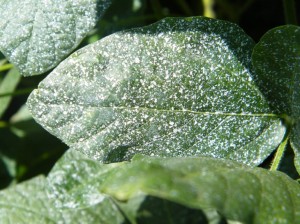What is Kaolin?
Kaolin is a naturally occurring clay resulting from weathering of aluminous minerals. It is used as an anti-caking agent in processed foods and an additive to cosmetics, toiletries and health products. It is also used as an ‘inert’ carrier in some pesticides, and enhances the performance of some microbial products.
In Australia, the crop protectant Surround® is registered in horticultural crops to protect from sunburn. The product is labelled as supressing insects in some countries (refer to labels at the Novasource website)
How does it work?
As a physical barrier Kaolin may:
- prevent insects from reaching vulnerable plant tissue.
- act as a repellent by creating an unsuitable surface for feeding or egg-laying.
- disrupt the insect’s host finding capability by masking plant tissue colour.
- act as an irritant to the insect. After landing on a treated surface, particles of kaolin break off and attach to the insect’s body triggering an excessive grooming response that distracts the pest.
Application
Kaolin clay is available as a wettable powder to be mixed with water. Application can be made with most commercially available spray equipment but large amounts of water are required. To prevent caking, it is suggested that the material be added while mechanical agitation is running, or to first completely mix the needed amount in a small amount of water before filling up the tank to the recommended volume.
Periodic shaking is recommended to keep the material suspended in water. Efficacy is only successfully achieved with thorough coverage. Care should be taken to cover the entire surface of the crop.
Research
Kaolin has been trialled in Australian cotton for the control of mirids and stink bugs with preliminary results showing a reduction in feeding damage. The effectiveness of kaolin was further increased when kaolin was mixed with petroleum spray oils. It is thought that the kaolin made plants visually unrecognisable to the mirids and stinkbugs and the plant loses its suitability as a host. Pest movement and feeding may also reduce as kaolin particles attach to the insect body.
More research is needed into the efficacy of kaolin – it has shown some potential against boll weevils and silverleaf whitefly, although one trial found that it increased aphid infestation, possibly due to temperature differences.
Further information
- Surround® crop protectant (AgNova)
- Video: Organic Insect and Sun Protectant (Novasource)
- Kaolin cons cotton suckers (PDF – Australian Cottongower magazine)
- Kaolin spraying protects cotton plants against damages by boll weevil (Journal of Pest Science)
- Kaolin particle film associated with increased cotton aphid infestations in cotton (PDF – Entomologia Experimentalis et Applicata)

